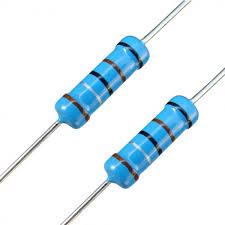Resistance 5938
If the resistance of the first resistor is 100 ohms and the voltage ratio on the first and second resistors is 2:1. What will be the resistance of the second resistor connected in series?
Final Answer:

Tips for related online calculators
Check out our ratio calculator.
You need to know the following knowledge to solve this word math problem:
basic operations and conceptsthemes, topicsGrade of the word problem
Related math problems and questions:
- Serial connection
 If the voltage on the first resistor is 6 V and the resistance ratio of the first and second resistors is 1:3, what will be the voltage across the second resistor if they are connected in series?
If the voltage on the first resistor is 6 V and the resistance ratio of the first and second resistors is 1:3, what will be the voltage across the second resistor if they are connected in series? - Resistance 5939
 If the resistance of the first resistor is 200 ohms and the resistance of the second resistor is 600 ohms. What will be the ratio of the electrical voltage across the first resistor to the electrical voltage across the second resistor (both are connected
If the resistance of the first resistor is 200 ohms and the resistance of the second resistor is 600 ohms. What will be the ratio of the electrical voltage across the first resistor to the electrical voltage across the second resistor (both are connected - Resistance 80351
 We connected two resistors in parallel in the circuit, with the first having three times the resistance of the second. The voltage between the terminals of each resistor is 6 V. Calculate the current through each branch when the resulting resistance of bo
We connected two resistors in parallel in the circuit, with the first having three times the resistance of the second. The voltage between the terminals of each resistor is 6 V. Calculate the current through each branch when the resulting resistance of bo - Two resistors 5
 Two resistors are connected in parallel. The first resistor has a resistance of 2000 ohms and a current of 4 mA flows through it. The second resistor has a resistance of 1600 ohms. 1/Draw a circuit diagram 2/Determine the voltage of the power source. 3/Wh
Two resistors are connected in parallel. The first resistor has a resistance of 2000 ohms and a current of 4 mA flows through it. The second resistor has a resistance of 1600 ohms. 1/Draw a circuit diagram 2/Determine the voltage of the power source. 3/Wh - Resistances 25271
 Three resistors with resistances of 200 Ω, 400 Ω, and 600 Ω are connected in series (in series)—a current of 1.8 A flows through the first 200Ω resistor. a) What current passes through the second and what current through the third resistor? b) What are th
Three resistors with resistances of 200 Ω, 400 Ω, and 600 Ω are connected in series (in series)—a current of 1.8 A flows through the first 200Ω resistor. a) What current passes through the second and what current through the third resistor? b) What are th - Resistors 5915
 If the current flowing through the first resistor is 200 mA and the second is 0.4 A, what will be the ratio of the first and second resistors connected in parallel?
If the current flowing through the first resistor is 200 mA and the second is 0.4 A, what will be the ratio of the first and second resistors connected in parallel? - Kirchhoff's law
 Two resistors with 100 Ω and 300 Ω resistors are connected in series. A current of 1.8 A passes through the first 100Ω resistor. What current flows through the second resistor?
Two resistors with 100 Ω and 300 Ω resistors are connected in series. A current of 1.8 A passes through the first 100Ω resistor. What current flows through the second resistor?
